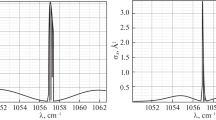Abstract
In this paper we develop a new static model for boron isotope separation by the laser assisted retardation of condensation method (SILARC) on the basis of model proposed by Jeff Eerkens. Our model is thought to be adequate to so-called two-step iterative scheme for isotope separation. This rather simple model helps to understand combined action on boron separation by SILARC method of all important parameters and relations between them. These parameters include carrier gas, molar fraction of BCl3 molecules in carrier gas, laser pulse intensity, gas pulse duration, gas pressure and temperature in reservoir and irradiation cells, optimal irradiation cell and skimmer chamber volumes, and optimal nozzle throughput. A method for finding optimal values of these parameters based on some objective function global minimum search was suggested. It turns out that minimum of this objective function is directly related to the minimum of total energy consumed, and total setup volume. Relations between nozzle throat area, IC volume, laser intensity, number of nozzles, number of vacuum pumps, and required isotope production rate were derived. Two types of industrial scale irradiation cells are compared. The first one has one large throughput slit nozzle, while the second one has numerous small nozzles arranged in parallel arrays for better overlap with laser beam. It is shown that the last one outperforms the former one significantly. It is argued that NO2 is the best carrier gas for boron isotope separation from the point of view of energy efficiency and Ar from the point of view of setup compactness.






Similar content being viewed by others
References
J.R. Lamarsh, Introduction to Nuclear Engineering, 2nd edn. (Addison-Wesley, 1983)
P.A. Bokhan, V.V. Buchanov, N.V. Fateev, M.M. Kalugin, M.A. Kazaryan, A.M. Prokhorov, D.E. Zakrevsky, Laser Isotope Separation in Atomic Vapor (WILEY-VCH Verlag GmbH & Co. KGaA, Weinheim, 2006)
A. Steigerwald et al., J. Appl. Phys. 112, 013514 (2012)
P.F. Wang et al., J. Appl. Phys. 111, 063517 (2012)
R.F. Barth, Appl. Rad. Isotopes 67, S3–S6 (2009)
J.W. Eerkens, Nuclear Sci. Eng. 150, 1–26 (2005)
V.N. Bagratashvili, V.S. Letokhov, A.A. Makarov, E.A. Ryabov, Multiple Photon Infrared Laser Photophysics and Photochemistry (OPA, Amsterdam, 1985)
J.W. Eerkens, Chem. Phys. 269, 189–241 (2001)
J.W. Eerkens, Chem. Phys. Lett. 430, 271–276 (2006)
N.V Karlov et al., ZhETF Pis. Red. 11(4), 220–222 (1970)
J.W. Eerkens, Rocket Radiation Handbook, Vol. II. Model Equations for Photon Emission Rates and Absorption Cross Sections. (Air Research Manufacturing Company, 1973)
J.W. Eerkens, Laser Particle Beams 16, 295–316 (1998)
J.M. Zellweger, Phys. Rev. Lett. 52(7), 522–525 (1984)
H. Van den Bergh, Laser und Optoelectronik 3, 263 (1985)
G. Herzberg, Molecular spectra and Molecular Structure. Vol. II (Krieger Publishing Company, Malabar, 1991)
J.W. Eerkens, Chem. Phys. 293, 112–153 (2003)
J.W. Eerkens, Laser Particle Beams 23, 225–253 (2005)
A.V. Arefiev, High Energy Density Phys. 6, 121–127 (2010)
V.S. Letokhov, Laser Control of Atoms and Molecules (Oxford University Press, New York, 2007)
G.W.F. Drake (ed.) Handbook of Atomic, Molecular, and Optical Physics (Springer, Berlin, 2006)
R. Courant, K.O. Friedrichs, Supersonic Flow and Shock Waves (Interscience Publishers, Inc., New York, 1956)
M. Kumar, V. Gupta, A.K. Nath, Appl. Phys. B 80, 757–763 (2005)
Maple 15: http://www.maplesoft.com
D.M. Hoffman, Handbook of Vacuum Science and Technology (Academic Press, New York, 1998)
Acknowledgments
This work was supported by Priority Research Centers Program through the National Research Foundation of Korea (NRF) funded by Ministry of Education, Science and Technology (2010-0020077). One of the authors (K.L.) also appreciates support from the grant “the 2nd phase BK21 project”.
Author information
Authors and Affiliations
Corresponding author
Rights and permissions
About this article
Cite this article
Lyakhov, K.A., Lee, H.J. Basic features of boron isotope separation by SILARC method in the two-step iterative static model. Appl. Phys. B 111, 261–272 (2013). https://doi.org/10.1007/s00340-012-5328-7
Received:
Accepted:
Published:
Issue Date:
DOI: https://doi.org/10.1007/s00340-012-5328-7




